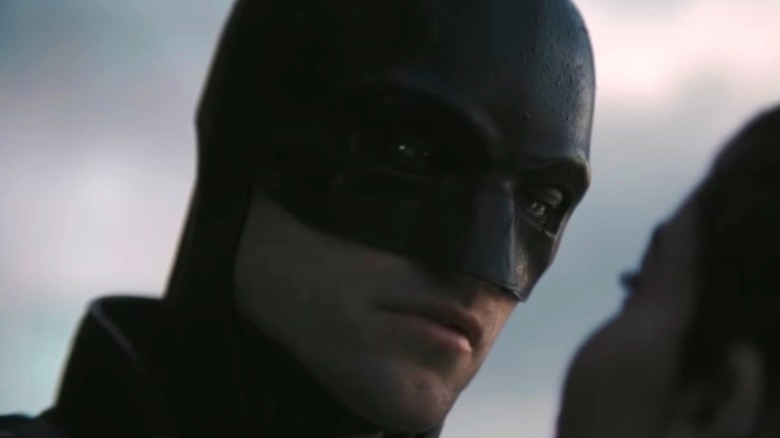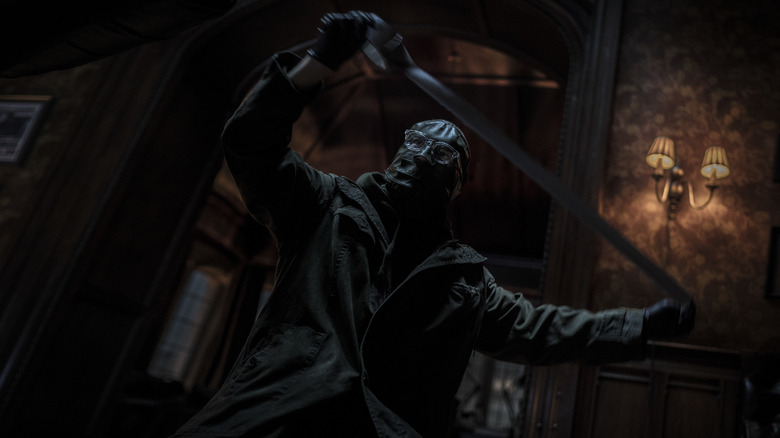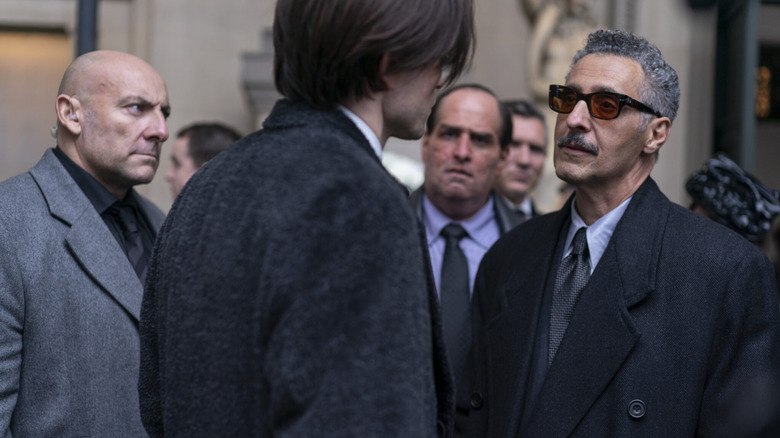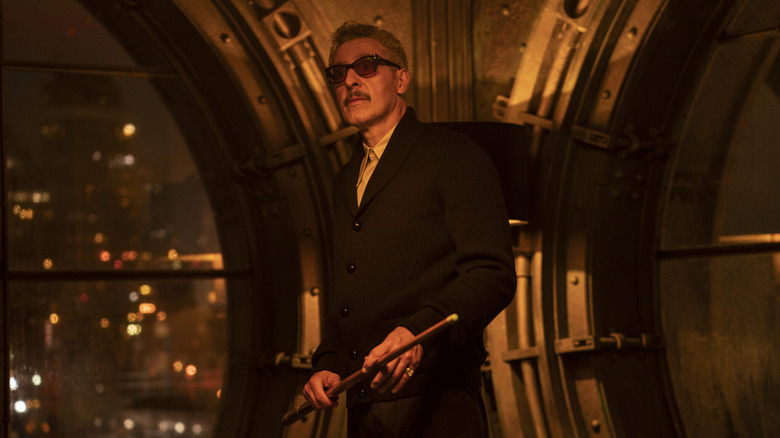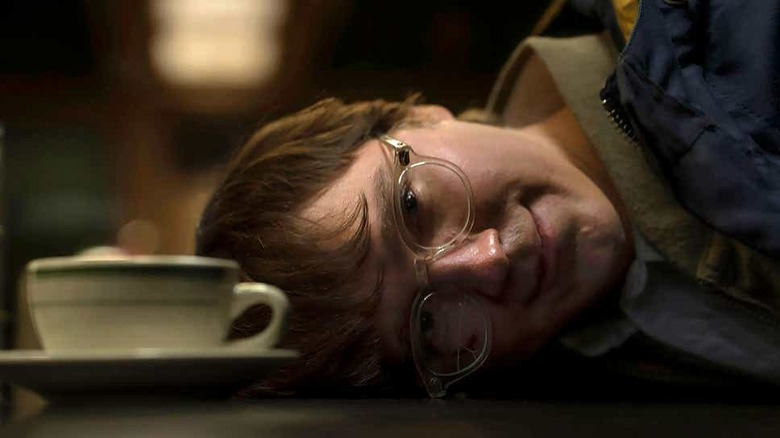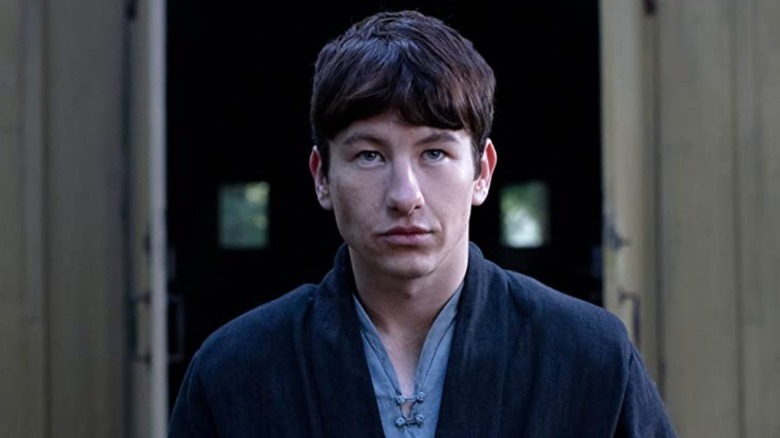The Batman's Most Confusing Moments Explained
"The Batman" is one of the more information-dense blockbusters in recent memory. To be clear, we really only consider it a blockbuster because it cost upwards of $200 million and has Batman in the title. If you take out the one car chase, the final act's citywide catastrophe, and the handful of hand to hand combat scenes, it feels more like director Matt Reeves fleeced Warner Bros into spending a quarter of a billion on some longstanding fantasy of his to make the biggest, most expensive film noir homage imaginable.
The movie runs three whole hours and features an intricate, densely plotted murder mystery at its center. However, it's not just the content of the film's narrative but the specific way in which it is told that may leave viewers scratching their heads over various details. It's a film that relies heavily on intercut glances and lingering shots of minor clues, all of which may work against the expectations of audiences that have grown used to paying less attention to what is happening on screen due to years of conditioning suggesting that it'll all be explicitly explained in one way or the other.
However, that means trying to sit through a three-hour movie that leaves the heavy lifting of putting two and two together to the viewer may result in some equations being left unsolved until a second viewing is possible. These are some of the moments that may have initially been confusing, explained.
That intro...
In interviews promoting the film, star Robert Pattinson talked about how different Reeves' vision for the source material was and how that was something viewers would find evident from the film's shocking opening moments. He wasn't wrong, either. The film opens with a POV shot of peering through a window of a large home, where a small child in a Halloween costume is play sword-fighting with what appears to be his father. But the image is soft, focus-wise, and the "perspective" darts around so much that, coupled with the heavy breathing on the soundtrack, it's initially unclear what we're looking at.
It's a jarring but appropriate way for a film like this to open. For even the briefest of moments, we wonder if what we're seeing is a young Bruce Wayne sparring with Alfred before leaving with his parents to see "The Mark of Zorro" on that fateful night, a lingering thought that later dovetails nicely with this child's grief mirroring Bruce's.
But, no, it's just The Riddler stalking his prey, Gotham's corrupt Mayor, before going in for the kill. However, that introductory abstraction and the patience taken to let it drift in front of the viewer for as long as it does really sets up the tone and pace of the following film.
Hippocratic oath?
The first time we see John Turturro's inspired performance as mob boss Carmine Falcone, it's through Selena's eyes as Bruce monitors her infiltration of 44 Below, the secret hangout for Gotham's corrupt elite within the Iceberg Lounge. However, the first time he and Bruce meet face to face, it's at the mayor's funeral, where Falcone remarks how Bruce is the only person in the city more reclusive than he is. Falcone tells a brief story about how Thomas Wayne once saved his life. He explains that he got shot and couldn't go to a real hospital, so he showed up on their doorstep, with Bruce's father operating on Falcone on the dining room table, while Bruce watched from afar.
"You don't think that means something?" Falcone asks Bruce. Bruce says it means his father took the Hippocratic Oath, something every doctor must do. Falcone repeats his words to him and begins to laugh. A soft chuckle at first, then something much heartier, down from the depths of his gullet. Bruce doesn't understand what's so funny, and in the moment, neither do we. But just like all of The Riddler's clues throughout the film, it's a pun.
"Hippocratic" sounds to Falcone like "hypocrite." Even though Bruce thinks his father was a good man, Falcone remembers the day Thomas Wayne asked him to handle a problem for him that resulted in a murder, so he finds it utterly hilarious this overgrown boy doesn't know the full scope of his own father's complex morality. Later, Alfred clarifies the nature of Thomas and Carmine's relationship, repairing the damage Falcone does to Bruce with his later revelations. However, Falcone's demeanor here suggests that he really does feel that Thomas was asking him to kill and that despite his manipulative machinations, he thinks any other interpretation is a joke.
She was strangled...
Selina and Bruce first truly bond when she breaks down and reveals that his initial suspicions about her are wrong. Bruce is worried that she is in some way romantically involved with Carmine Falcone or that she pretended to be to pull off a score. But she explains that Falcone is her father, and she has been looking to get even with him her entire life. Selina's mother used to work at 44 Below and used to bring her around as a child, but Selina always felt uncomfortable with the way Falcone looked at her. Once we know this fact, we assume that Falcone knows that Selina, today, is his daughter, but he doesn't realize who she is until she points a gun at him and says, "this is for my mother," after asking if he remembers Maria Kyle. Turturro's performance cinches that the mere recollection of that name puts it all together for him.
But it's the revelation that Falcone was the one to murder her mother that is one of the film's more nuanced reveals. When Selina tells her tragic origin story to Bruce, she mentions that after her mother was murdered by strangulation, Falcone didn't lift a finger to help and let her get swallowed up by Gotham's awful social services system.
It's not until Annika's fateful voicemail is discovered on Selina's voicemail that we're able to put the rest of the pieces together. On the recording, we can hear that Falcone is not only the rat they've been searching for, but that he's the one who personally killed Annika and that he did it with his bare hands around her neck. Bruce and Selina lock eyes in the uncomfortable mutual understanding that Falcone is a man who likes to get his hands dirty and that he's likely the one who killed her mother.
This is confirmed even further when Falcone turns the tables on a vengeful Selina, trying to choke her with a pool cue, then, with his hands — "Just like your mother."
The end of The Batman
Once The Riddler has been caught, he is revealed to be forensic accountant Edward Nashton, a traumatized orphan who uncovered the rot at the core of the Gotham Renewal Fund. Discovering how truly corrupt the city is, and the levels of greed that caused him to have such a horrid upbringing by a system thieved from those it was supposed to protect, turns him into a vengeful killer.
When rooting through his apartment for more clues about his motivations, they see that he has one last password-protected video to unlock. Based on his news clippings, Bruce is concerned that Nashton has figured out who The Batman really is. So when Gordon gets a call that The Riddler wants to see him at Arkham, he assumes his entire crime fighting career is about to come to an end. He calls it "the end of The Batman," and even though he ends up being wrong, he's not entirely wrong. This may not be the end of The Batman, but it does lead to an end for this Batman.
When he arrives at Arkham, Nashton tells his long story about how he hated Bruce Wayne while growing up in an orphanage. To Nashton, it seemed that the only sympathy the city had for lost children was placed on a billionaire kid who lived in a mansion. It feels like Nashton is ramping up to telling The Batman why he hates him, but it becomes clear that he's not taunting him about knowing he's Bruce Wayne but rather lamenting the fact that together, the two of them got every one of his targets except Wayne.
Nashton isn't talking to Batman as an adversary, but as a partner. He sees them as collaborators. They're both vengeful, angry men who suffered in their youth and want to root out corruption and see justice served, but one of them lacked the physical might to do the heavy lifting, so his mission took on a different tenor.
This moment and its implications are the beginning of the end for Bruce relying entirely on fear and violence. He sees the limits of what he has done, and worse, sees the evil his war on crime has inadvertently inspired. This is where he learns that he'll need to become something more.
THAT scene in Arkham
Another major piece of portent takes place within Arkham's walls before the final credits begin to roll. As Gotham City struggles, living to fight another day, Nashton has a meltdown in his cell now that Batman has thwarted his plans. But a friendly voice two cells over comforts him. Through their interaction, it becomes pretty clear that the individual Nashton is befriending is supposed to be The Joker, or whatever Matt Reeves' vision may be for a future iteration of The Joker.
However, what's confusing is Barry Keoghan's casting. Leading up to the film's release, there were rumors from test screenings that he was going to be in the film. But until it was reported that he was playing Stanley Merkel, a cop from Frank Miller and David Mazzucchelli's "Batman: Year One," fans assumed the unconventional young thespian must be playing The Joker in some kind of post-credits scene. This scene taking place before the film's actual closing moments is a bit of a shock, but largely because it begs the question of how The Joker ended up in Arkham.
Is he already The Joker? He's got the laugh, even if it seems more muted and naturalistic than most portrayals of the character. We can't quite see his face, but his silhouette implies he may have the facial scarring Heath Ledger had in "The Dark Knight." If he's already become The Joker, how did he end up in Arkham? Did Batman already catch him in a previous adventure during his first year? Do we really need another live-action Joker so soon after Joaquin Phoenix's Oscar-winning turn with the character?
We'll just have to trust in Matt Reeves' vision.
